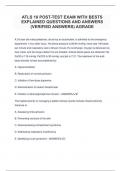Summary
Summary Strategy and Innovation Management - Articles and Lectures
- Course
- Institution
This is a summary of the course "strategy and innovation management" (University of Groningen). It contains a concise summary of all articles including lecture notes. The summary was written in block 1 of 2022, so for now it is completely up to date.
[Show more]







